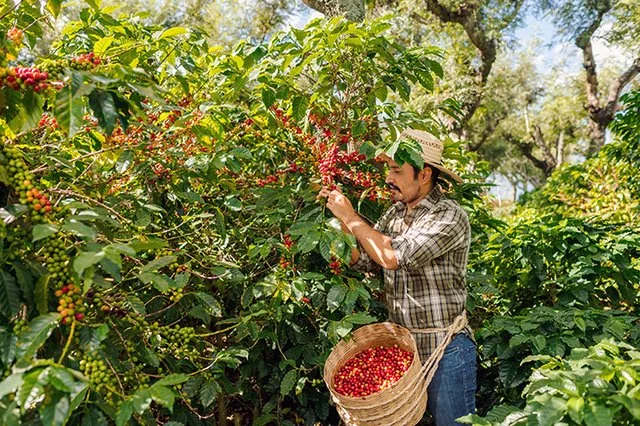Carbon Footprint of Coffee
Coffee is the world’s most widely traded tropical agricultural commodity, and our favorite morning pick-me-up. From a wide variety of beans and brews to coffee shops seemingly at every corner in town, the omnipresence of coffee is unlike that of any other beverage in the world. But like any of the world’s top commodities, the coffee industry is not without a hefty carbon footprint.
According to the Carbon Disclosure Project (CDP), one black cup of coffee equals approximately 0.258 kg CO2e. While this may not seem like much, consider the hundreds of millions (if not billions) of people worldwide who consume at least one cup of coffee per day. Add in packaging emissions, food waste, and the additional footprint of milk and sweeteners, and coffee ranks among the foods with the highest carbon footprints—right after beef, lamb, cheese, and dark chocolate. (Chart: https://interactive.carbonbrief.org/what-is-the-climate-impact-of-eating-meat-and-dairy/index.html)
In this blog, we break down where exactly these emissions come from—analyzing coffee farms, processing, brewing types, and more—and whether they can ever be lowered.
Farming and Harvesting Coffee
Coffee’s first impact on the climate takes place before the growing process even begins—when forests and habitats are entirely wiped out to make way for coffee farms. Deforestation accounts for nearly half of a cup of coffee's greenhouse gas (GHG) footprint, according to the World Wildlife Fund’s publication, Measuring and Mitigating GHGs: Coffee. The authors also provide an estimate that 0.13 million hectares have been lost annually over a 20-year period.
Along with deforestation and habitat clearing, the farming process itself produces emissions. The use of synthetic fertilizers and the release of nitrous oxide contribute to the 0.9-8 kgCO2e/kg RC on farms. Farms that adopt agroforestry and organic farming systems can decrease these emissions and, potentially, increase productivity and profit long-term.
Working Conditions and Fair-Trade Farming
Emissions are not the only issues on coffee farms. Despite coffee being a billion-dollar industry, smallholders struggle to support themselves as coffee producers due to unfair wages, exploitative labor practices, and environmental challenges.
A 2020 study by the International Labour Organization collected data from the coffee sector in five major coffee-producing countries: Costa Rica, India, Indonesia, Ethiopia, and Vietnam. The authors found that in Costa Rica and India, most workers are paid employees, whereas in Indonesia, Vietnam, and Ethiopia, smallholder farmers are often not officially hired and are frequently unpaid. In all five countries, “wages are far below the average country wages.”
Along with low wages, coffee farmers in certain countries, such as Guatemala, must work long hours, sometimes in extreme heat, to earn enough to support themselves and their families. Without protective gear and more ethical working conditions, many face health consequences.
Sustainability programs aim to improve conditions on coffee farms. Fairtrade ensures that its more than 775,000 certified coffee farmers make a minimum wage regardless of market volatility. The organization also helps farms adapt to climate change and empowers farmers to negotiate better trade terms.
Likewise, Rainforest Alliance certifies farms that produce popular goods, including coffee, based on whether they meet the Rainforest Alliance Sustainable Agriculture Standard. The certification “means that farms and companies support healthy forests, better farmer livelihoods, human rights, good environmental practices, as well as climate resilience.”
These certifications are a step in the right direction, but political and economic policy changes are ultimately needed to address inequities on all coffee farms.
Processing, Shipping, and Packaging
Coffee harvests go through several stages before hitting the shelves: including processing, shipping, and packaging. Emissions vary depending on the type of processing that turns a coffee cherry into a bean. Likewise, the form of shipping and retailer packaging practices affects the total emissions.
Wet vs. Dry Processing
There are two main types of coffee processing methods: wet and dry. They produce drastically different coffee flavors.
Wet or washed-process coffee produces more emissions due to its significant use of water and electricity. There are three key stages in the production of wet-processed coffee: pulping, fermentation, and drying. This process produces beans that are often lighter, more acidic, and have floral or citrus notes.
Dry processing is a more straightforward method that emits less GHG. The fruit is left intact and dries in the sun for several weeks. Natural processing enhances fermentation, resulting in sweeter, fruitier beans.
Transportation and Retailer Packaging
While shipping coffee to retailers and packaging for retailers produce less emissions than coffee’s earlier life cycle stages, the numbers still add up. International transport accounts for about 15% of coffee’s greenhouse gas (GHG) emissions, according to an Energy Nexus study, and shipping in general relies on heavy fuels that emit 6-11%.
Packaging emissions depend on the type of coffee product. Single-use pods, for example, are significantly more emission-heavy than large bags of beans or grounds. Environmentally conscious companies may use compostable films and bioplastics for packaging to reduce their footprint.
Brewing vs. Buying
Whether you make coffee at home, along with how you make coffee, also determines your cup’s total emissions.
Emissions Per Brewing Method
Brewing methods that use minimal resources are usually the most sustainable. A study in Sustainable Production and Consumption discovered that, out of the four production methods they tested, Moka pot preparation on an induction- or gas-fired stove produced the lowest amount of emissions. After that were the capsule coffee machine, the pod coffee machine, and the espresso coffee machine. The authors note, however, that the coffee pod and capsule machines have extra emissions due to their packaging.
Aside from packaging, your use of electricity while making coffee contributes to increased emissions. A coffee pot on a hot plate can emit between 2.5 and 6 kgCO2e/kg while running. If you are only making a single cup, a French press, Moka pot, or pourover coffee maker is best for reducing waste and resources.
Your Cafe Order
Consider how much energy coffeeshops (both commercial names and local cafes) use between electric coffee machines, refrigerators, and water use. Now add on the waste they produce, mainly in the form of disposable cups and straws. For these reasons, brewing at home has the immediate environmental advantage.
Order something other than a black coffee, such as a specialty latte or a signature drink with cold foam or flavor shots, and the emissions creep up further. CDP estimates that a latte produces 0.844 kg CO2e (up from black coffee’s 0.258 kg CO2e) due to the addition of milk. Dairy, in particular, requires higher water and land use than plant-based milks, such as oat and soy milks.
While one person’s coffee order may not significantly contribute to the acceleration of climate change, our collective and cultural coffee habits do.
How Climate Change Is Shaping the Coffee Industry
Coffee’s impact on our climate is clear. But what about climate change’s effects on the coffee industry?
Due to the environmental impacts of climate change, coffee farms and cherry yields are expected to drop by 2050. The impacts we may experience include “drought, salinity, biodiversity decline, suitability losses, change of species seed availability, [and] resistance to abiotic and biotic stressors,” according to a PubMed Central review. Coffee growers, in particular, are already bearing the brunt of these changes.
We can see the consequences of climate change in grocery stores, as well. Ground roast coffee has recently reached an average price of $8.41 per pound, a 33% increase since last year. This is largely due to destructive weather events that have reduced harvests for growers in Brazil and Vietnam, according to CNBC. In addition, the recent tariffs on Brazil will continue to be a contributing factor to the rise in coffee costs.
Making Coffee More Sustainable
WWF lists several mitigation practices at the government and farm levels that would lower emissions, protect habitats, and benefit farmers.
Stop deforestation: Not clearing land for coffee farms would make the largest difference in GHG emissions.
Adopt agroforestry: Ideally, our current coffee farms would adopt agroforestry practices, such as alley cropping and forest farming, that increase biodiversity and prolong the life of farms.
Use organic fertilizer: Along with agroforestry, using a balanced, organic fertilizer made of the waste from coffee processing can reduce emissions.
CDP also advises that retailers adopt more sustainable packaging and that cafes and consumers compost their used grounds for sustainable waste management. Coffeeshops can also invest in solar-powered roasting methods to decrease their energy emissions.
What You Can Do
Looking to lower your own coffee carbon footprint while still enjoying your morning cup? Here are some tips to refine your coffee habits:
Only make what you’ll drink: Try to be conscious of how much coffee you’re making and how much is leftover when everyone’s done drinking.
Search for sustainable beans: Buying certified organic and Fairtrade coffee supports ethical working conditions for farmers and more sustainable farming practices.
Brew at home or buy locally: Make coffee at home as much as possible. If you do buy from a cafe, consider visiting a local coffee shop to support small businesses. Don’t forget to bring your reusable coffee cup or mug to cut down on waste.
Practice regular energy-efficient habits: Turn off your coffee pot and water heater when you’re done using them.





